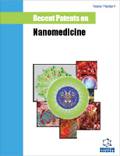Abstract
Nanomedicine addresses issues such as the use of nanotechnology, nanomaterials, and nanosensors for advanced medical applications, by utilizing the improved chemical, physical and biological properties of nanostructured materials. Polymers and biopolymers have been effectively used to formulate various types of nanoparticles such as micelles, liposomes, dendrimers, and hydrogels, which are mostly used as imaging and therapeutic agents. The demanding process of developing new biodegradable polymers mainly looks towards to synthesize copolymers to embed hydrophilic segments in the hydrophobic chains of the polymers, and in turn to create nanoparticles having unique delivery characteristics (i.e. specific targets and proper release rates). Such efforts are continuously disclosed in various patents either from drug industry or from academia. The present brief review is mainly focused on the previous types of polymeric nanoparticles as drug delivery systems and related current technologies of synthesis, along with recent patented disclosing methods of novel polymer architectures.
Keywords: Biopolymers, drug delivery, mucoadhesive, nanogels, nanoparticles, peptides, polysaccharides
 29
29

